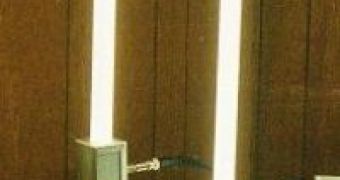This device is a prototype of an antenna, which uses ionized gas instead of metal to transmit and receive signals, decreasing interference and boosting the functionality. Some of its key features include the ability to focus a signal beam easily and to communicate signals in very short pulses, which could prove extremely useful in the areas of digital communications and radar.
These kinds of antennas could prove themselves a valuable asset on a battlefield, where they could be easily kept out of sight, reduce the number of conventional antennas and the weight of the structure carrying such an antenna, prevent signal jamming attempts through rapid adjustments in the frequency, direction, bandwidth and other parameters.
Solid metal antenna can function because electrons move freely in the metal conductor. This electronic movement is made even more easily inside the plasma antenna, because of electrons in a free state inside the hot gas. Plasma can only exist while the gas is kept very hot; as soon as the heat source is shut off, the plasma antenna returns to its previous state, in which cold gas is non conductive, but the signal emitted or received by the antenna disappears only when the plasma cools down.
Conventional metal antennas can pick up various noises, or interference that bounce of the surrounding metal objects, meaning either another nearby antenna or equipment. This can be easily canceled out by the plasma antenna, since it only needs to be functional during the transmission or reception of a signal, greatly reducing the effects of interference.
Potential commercial users can be found everywhere, from military forces to telephone operators and simple people. The producing company continues to study the commercial potential of its technology.
ASI Technology Corporation, the developing company of the revolutionary antenna, was found in the 1930s and was originally a mining company, but now provides a number of services from feasibility analysis, harware design and development, to experimental testing to produce prototype systems.
The antenna designed by ASI will be presented next week at the ASP Division of Plasma Physics in Orlando and consists of ceramic tubes filled with gas and emits light similar to the florescent illuminating tubes. Physicists presenting the prototype will propose a design composed of an array of many small plasma elements, which could lead to a more versatile antenna, that could be easily configured, by turning on and off parts of the elements.

 14 DAY TRIAL //
14 DAY TRIAL //